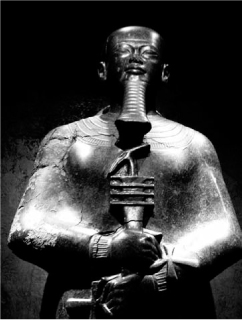Egyptian MythologyEgyptian Religion and Mythology |
Where were the main religious centers of Egypt? |
Several religious, cultural, and political centers achieved relative importance or dominance at particular times in Egyptian history. Although Egyptian religion and mythology have a certain consistency that transcends the various centers, each center did emphasize particular deities and stories.
The most ancient center was Memphis, so named later by the Greeks. Memphis was the capital city of the province of Aneb-Hetch. In about 3000 B.C.E. it became the capital of the newly united Upper and Lower Egypt under the First Dynasty king, Menes. The ruins of Memphis are in the present-day town of Mit Rahina, near Cairo in Lower Egypt. The primary god and creator of Memphis was Ptah, who created with his heart and tongue. He wore a beard and a craftsman’s cap; his consort was the lion-headed Sekhmet. Ptah was a great craftsman—a deus faber— a craft deity who, like Hephaistos (Vulcan) in Greece, could make beautiful objects, including new bodies for the dead. The temple of Ptah—Het ka Ptah—became “Aigyptos” in Greek and “Egypt” in English.
Thebes was the Greek name of Waset (modern day Luxor). Founded in about 3200 B.C.E., Thebes was the major city of Upper Egypt and at various times was the capital of all of Egypt. The great temple of Karnak is situated near the city. The chief god and creator here was Amun, the “Hidden One,” sometimes depicted with a ram’s head. He represented sexual power and was associated with a partner, “God’s Hand,” who used that hand to arouse Amun so that he could create. Later he would be associated with the sun god Ra as Amun-Ra. His queen was Mut, and their son was the moon god Khonsu.
In Dendera, north of Thebes, Hathor, the ancient cow goddess whose headdress combined a solar disk and a pair of cow’s horns, was the “Eye of Ra”—the solar disk of Heaven itself. She was also associated with another Horus, her son, who was especially celebrated at nearby Behdet (Edfu).
The town of Khmun (Hermopolis) in Middle Egypt was named Hermopolis by the Greeks, after their god Hermes, whom they believed to be the same as the Egyptian god Thoth, a god of wisdom and hidden knowledge and the inventor of writing. The town was originally known as Eight-Town because of a group of eight gods—the Ogdoad (The Eight)—worshipped there. These primeval gods represented the original matter of the world. The Ogdoad consisted of four male and female pairings. Nun and Naunet were the primordial waters. Amun and Amunet were air—the source of life. Kek and Keket were darkness. Heh and Hehet were chaos, or infinity.
The town of Hnes in Lower Egypt, south of Memphis, was called Herakleopolis by the Greeks, after their hero Herakles, whose identity they associated with the ram god Heryshef, the chief god of the city. Heryshef was sometimes thought to be a form of the god Osiris.
By far, the most influential cult center in ancient Egypt was the city of Iunu, named Heliopolis (City of the Sun) by the Greeks because of the predominance there of the great sun god Ra (Re).

This statue at Italy’s Turin Museum is an image of the Egyptian god Ptah, the primary god and creator of Memphis.
